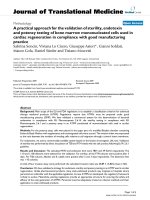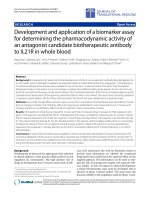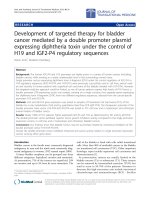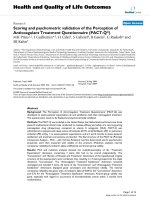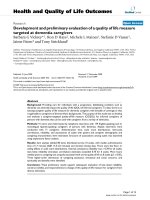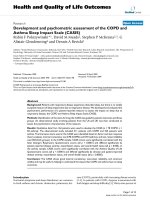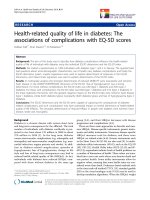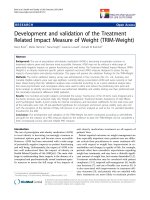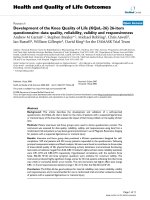báo cáo hóa học: " Development and validation of the WEll-being and Satisfaction of CAREgivers of Children with Diabetes Questionnaire (WE-CARE)" potx
Bạn đang xem bản rút gọn của tài liệu. Xem và tải ngay bản đầy đủ của tài liệu tại đây (344.31 KB, 9 trang )
BioMed Central
Page 1 of 9
(page number not for citation purposes)
Health and Quality of Life Outcomes
Open Access
Research
Development and validation of the WEll-being and Satisfaction of
CAREgivers of Children with Diabetes Questionnaire (WE-CARE)
Joseph C Cappelleri*
1
, Robert A Gerber
1
, Teresa Quattrin
2,3
,
Rosemarie Deutschmann
4
, Xuemei Luo
1
, Robert Arbuckle
5
and Linda Abetz
5
Address:
1
Pfizer Global Research and Development, Groton, CT, USA,
2
Women's and Children's Hospital of Buffalo, Buffalo, NY, USA,
3
State
University of New York, Buffalo, NY, USA,
4
Deutschmann and Company, Mt. Sheridan, Australia and
5
Mapi Values, Bollington, UK
Email: Joseph C Cappelleri* - ; Robert A Gerber - ;
Teresa Quattrin - ; Rosemarie Deutschmann - ; Xuemei Luo - ;
Robert Arbuckle - ; Linda Abetz -
* Corresponding author
Abstract
Background: This study was designed to develop a diabetes-specific questionnaire on parents'
quality of life and satisfaction with their child's diabetes treatment, the WEll-being and Satisfaction
of CAREgivers of Children with Diabetes Questionnaire, and to conduct psychometric validation
of the WE-CARE.
Methods: Parents of 116 children aged 6 to 11 years were enrolled in the United States. Children
had type 1 diabetes mellitus for > 1 year, had been treated with subcutaneous insulin for ≥ 2
months, and had a recent glycosylated hemoglobin (HbA
1C
) measurement. Recruiting clinicians
provided clinical information on the children. Over a two-week period, parents completed WE-
CARE (initial 68 items) and two other questionnaires (the 36-item Short Form of the Medical
Outcomes Study and the 50-item Child Health Questionnaire-Parent Form) twice.
Results: A literature review and one-on-one interview with caregivers and pediatricians led to the
development of a draft questionnaire consisting of 68 items. Factor analysis suggested retention of
37 of the 68 initial items grouped into four multi-item scales (Psychosocial Well-being, Ease of
Insulin Use, Treatment Satisfaction, and Acceptance of Insulin Administration as well as a Total
Score). The four multi-item domains of WE-CARE were found to be psychometrically robust –
they had negligible floor and ceiling effects, excellent internal consistency and test-retest reliability,
high item-discriminant validity and good concurrent, divergent, known-group and clinical validity.
Moderate interscale correlations among the four WE-CARE domains indicated that the concepts
they measure were related but distinct.
Conclusion: These data suggest that WE-CARE provides a reliable and valid measure of parents'
well-being and treatment satisfaction related to their child's diabetes. While these results show
promise, additional validation of WE-CARE is warranted.
Published: 18 January 2008
Health and Quality of Life Outcomes 2008, 6:3 doi:10.1186/1477-7525-6-3
Received: 5 June 2007
Accepted: 18 January 2008
This article is available from: />© 2008 Cappelleri et al; licensee BioMed Central Ltd.
This is an Open Access article distributed under the terms of the Creative Commons Attribution License ( />),
which permits unrestricted use, distribution, and reproduction in any medium, provided the original work is properly cited.
Health and Quality of Life Outcomes 2008, 6:3 />Page 2 of 9
(page number not for citation purposes)
Background
The US National Institute of Diabetes and Digestive and
Kidney Diseases has suggested that one in every 400 to
600 children is affected by type 1 diabetes mellitus and its
associated risk factors [1]. By adolescence, children with
type 1 diabetes typically receive three or more insulin
injections per day [2], placing a substantial burden on
their parents. American Diabetes Association guidelines
emphasize that care of this population requires integrated
management of the complicated physical and emotional
needs of children and adolescents as well as of their fam-
ilies [3].
Previous studies have shown that parents experience
higher levels of stress in caring for a child with diabetes
than in caring for a healthy child [3-7]. However, there has
been a dearth of studies to quantitatively assess either the
well-being of parents of children with type 1 diabetes or
their satisfaction with their child's diabetes regimen. The
paucity of information in this area is not surprising, as
there have been a very limited number of instruments
measuring these factors.
The few relevant instruments that exist have some limita-
tions. For instance, the Parents Diabetes Quality of Life
Questionnaire (PDQOL) is a modified version of Diabe-
tes Quality of Life measure [8]. It assesses parents' percep-
tions of the effects of their child's diabetes, with three
subscales that assess parental life satisfaction as affected
by the child's diabetes, impact of the child's diabetes, and
disease-related worries. As a measure of quality of life, the
PDQOL does not assess parents' experience with diabetic
treatment, and the questionnaire's psychometric valida-
tion was limited to internal consistency reliability and
content validity.
The Pediatric Inventory for Parents, which has been used
for mothers of children with type 1 diabetes [9,10], is a
generic questionnaire that was not developed for parents
of children with diabetes. It does not measure parents' sat-
isfaction with diabetes treatments, and it has no existing
psychometric examination on its factor structure. (WE-
CARE measures concepts such as communication, medi-
cal care, emotional distress, and role function differently
from the Pediatric Inventory for Parents.) The Insulin
Pump Therapy Satisfaction Questionnaire measures par-
ents' satisfaction with their child's implantable insulin
pump [11]. Although disease-specific, this questionnaire
was only tested for internal consistency reliability (α =
0.69, which is less than the acceptable level of 0.70), and
its scope is limited to the insulin pump.
Given the lack of a well-validated instrument to assess the
well-being and treatment satisfaction for parents of chil-
dren with type 1 diabetes, we developed and validated a
new measure: the WEll-being and Satisfaction of CAR-
Egivers of Children with Diabetes Questionnaire. WE-
CARE measures the psychosocial well-being and treat-
ment satisfaction of parents who have a child with type 1
diabetes. Specific topics covered in WE-CARE include
overall burden of the parents/caregivers, their anxiety and
stress, influence on their social life, work, and families,
and satisfaction with diabetes treatment (such as admin-
istering and preparation of injections, carrying, storing
and disposing of the insulin, and flexibility in the use of
insulin).
Methods
The development of WE-CARE began with a literature
review, followed by one-on-one interviews conducted in
New York, NY, and Philadelphia, PA, with four pediatri-
cians, 20 children, and their primary caregivers. Findings
from the interviews were reviewed by a panel of four pedi-
atricians (distinct from the ones interviewed) and one
child psychologist, after which a draft questionnaire was
developed. Initial assessments of item and content valid-
ity resulted in a self-administered questionnaire consist-
ing of 68 items, which took about 20 minutes to
complete. A validation study comparing results on WE-
CARE to results on two previously validated quality-of-life
(but non-diabetes-specific) questionnaires was then con-
ducted.
Study subjects
Subjects were recruited into the validation study from dia-
betes clinics, specialists, and clinical investigators located
in four US cities: Buffalo, NY; Minneapolis, MN; Okla-
homa City, OK; and Tallahassee, FL. The study protocol
was approved by the institutional review board at each
center. Study participants (the children and their parents/
caregivers) were identified by clinical investigators and
given a detailed explanation of the protocol and corporate
funding of the study. Subjects provided informed written
consent, and child subjects were required to have written
permission and informed consent from a parent or legal
guardian.
Parents or caregivers of children with type 1 diabetes aged
6 to 11 years were eligible for entry into the study. Parents
received compensation of $100, and children were given
an age-appropriate gift valued at $50. Only one parent or
caregiver per child participated; the participant was
required to be the primary caregiver of the child, and had
to be willing to participate throughout the course of the
study and to complete the questionnaires at Weeks 0 and
2.
The questionnaires were administered at the diabetes
clinic, except for one site (Buffalo), where they were
administered at the parents' home. The children were
Health and Quality of Life Outcomes 2008, 6:3 />Page 3 of 9
(page number not for citation purposes)
required to have had a diagnosis of type 1 diabetes for at
least one year, and have been taking a stable regimen of at
least two subcutaneous injections of insulin or insulin
analog (16–150 IU per day) for two months prior to study
entry. They must have had a glycosylated hemoglobin
(HbA
1c
) measurement within the past two months.
Data collection
Clinicians reported child medical history, including year
of type 1 diabetes diagnosis, HbA
1c
values, height, weight,
history of diabetes complications, insulin treatment regi-
mens, other medications, and other medical conditions.
Parents/caregivers and children were excluded from the
study if they had any clinically significant major organ sys-
tem disease or psychiatric condition, or had experienced
major life stress or health changes in the two weeks
between baseline (test) and Week 2 (retest).
The study was conducted between January and August
2002. Parents/caregivers were asked to complete WE-
CARE at baseline (Week 0) and after two weeks (Week 2),
together with the 36-item Short Form of the Medical Out-
comes Study (SF-36) [12,13] and the 50-item Child
Health Questionnaire-Parent Form (CHQ-PF50) [14,15].
The SF-36 measures eight dimensions, including physical
functioning, role limitations-physical, pain, general
health perception, role limitations-emotional, vitality,
social functioning, and mental health. It can be summa-
rized into two component scores: physical component
summary and mental component summary.
The SF-36 has been tested and validated in a wide range of
patient groups [12,13]. The CHQ-PF50 is a global health-
related quality-of-life instrument for parents of children
aged 5 to 18 years [14,15]. It is intended to measure par-
ent's understanding of his or her child's general quality of
life based on 8 constructs, including physical functioning,
role limitations-physical, pain, general health percep-
tions, role limitations-emotional, behavior, mental
health, and self-esteem.
An additional four constructs assess the parents' perspec-
tives of how the child's health affects them and their fam-
ily through impact on parent's time, impact on parent's
emotions, impact on family, and family cohesion. All
analyses of the WE-CARE validation were based on assess-
ments at Week 0, except for test-retest reliability, which
incorporated assessments at Week 0 and Week 2.
Factor analysis
Initial factor analyses for item reduction were conducted
with the aim of establishing which of the provisional 68
items in WE-CARE belonged to domains or conceptual
areas and which items should be retained. Items were
deleted if they loaded on two or more factors, had a corre-
lation coefficient of < 0.40 with their own factor, or had a
high (> 70% of response) floor-ceiling effect – unless the
item was considered clinically relevant. Response options
to each item (question) were based on a five-point ordinal
scale, with higher response codes being more favorable.
All domain scores, once established, were transformed
onto a 0 to100 scale, with 100 being most favorable.
Reliability and validity
WE-CARE was assessed for the following battery of psy-
chometric properties: floor and ceiling effects (percentage
of subjects scoring the lowest and highest scores possible),
internal consistency reliability (satisfied if Cronbach's α
coefficient ≥ 0.70), test-retest reliability (satisfied if intra-
class correlation coefficient ≥ 0.70), item-convergent
validity (satisfied if item-scale correlation achieved ≥
0.40), item-discriminant validity (items correlated more
highly with their own scale than with any other scale),
scale-scale correlations (domains are related but distinct),
concurrent validity, divergent validity, known-groups
validity, and clinical validity.
Concurrent validity was examined through an analysis of
correlation between WE-CARE scores and mental compo-
nent summary of the SF-36. We expected that parents who
scored higher on WE-CARE (better psychosocial well
being and higher satisfaction with their child's diabetes
treatment) would have higher scores on the mental com-
ponent summary of the SF-36. This is because psychoso-
cial well-being is closely related to mental health, and
diabetic control in children has been linked to parental
depression and family instability [4]. We also expected to
see moderate to high correlations (> 0.4) between the WE-
CARE scores and the four CHQ-PF50 scales that assessed
the impact of the child's health on the parents and family,
Divergent validity was assessed by correlating the WE-
CARE scores with the physical component summary of
the SF-36 and by comparing the WE-CARE scores by child
age and gender. Child age was dichotomized (6–8 years
and 9–11 years), and then WE-CARE scores were com-
pared between the 2 age groups with a t test. Because the
WE-CARE primarily focuses on parents' psychosocial
well-being and the physical component summary of the
SF-36 assessed parents' physical health, we did not expect
that these two scores would be highly correlated. Neither
did we expect that the WE-CARE scores would be different
among children with different ages and genders, as we are
not aware of any published data or empirical evidence
that support this.
Known-groups validity was analyzed through the compar-
ison of the WE-CARE scores across groups of children with
type 1 diabetes with different health status. Because par-
ents have reported higher levels of stress when their child
Health and Quality of Life Outcomes 2008, 6:3 />Page 4 of 9
(page number not for citation purposes)
had poor health, i.e., chronic disease, and children's
health can directly impact parents' perception about their
child's treatment, we expected that parents of healthier
children with type 1 diabetes would report higher WE-
CARE scores. The health status of the child's type 1 diabe-
tes was assessed using an item of the CHQ-PF50 ("In gen-
eral, would you say your child's health
is ?") We
grouped responses into excellent/very good, good, and
fair/poor and compared WE-CARE scores across these
three groups.
Clinical validity was investigated by correlating child
HbA
1c
level with WE-CARE scores. Based on the previous
findings that diabetic control in children was linked to
parental depression and parental life satisfaction [4,16],
we expected that higher HbA
1c
scores in children (poor
diabetic control) would be associated with lower WE-
CARE score.
SAS/STAT
®
(SAS Institute, Cary, NC) software was used for
the assessment of factor analysis and for clinical and
known-groups validity. Multitrait Analysis Program-
Revised software [17] was used for the assessment of other
psychometric elements. For all tests, a significance level of
0.05 was used.
Results
One hundred sixteen parents and their children were
included in the study. Approximately 90% of the parents/
caregivers were female, usually mothers, with a mean age
of 37.1 years (Table 1). The majority of the subjects were
white. Because only one of the adults taking part in the
study was not the parent of the participating child, "par-
ents/caregivers" will hereafter be referred to simply as
"parents."
Parents were required to have completed all items in each
scale to be included in the factor analysis. There were no
missing items in 81.03% (n = 94) of questionnaires at
Table 1: Subject characteristics
Parent (N = 116) Child (N = 116)
Age (years), mean ± SD 37.1 ± 6.3 8.6 ± 1.7
Gender (male %) 9.5 52.6
Relation to child (%):
Mother 90.5 NA
Father 8.6 NA
Grandparent 0.9 NA
Ethnicity (%):
White 86.2 86.2
Other 13.8 13.8
Work status (%):
Not working due to child's health 4.3 NA
Not working for other reasons 6.0 NA
Looking for work 2.6 NA
Working full- or part-time 75.9 NA
Full-time homemaker 11.2 NA
Income in United States dollars (%):
<$30,000 29.3 NA
$30,000–$59,000 31.0 NA
≥$60,000 37.9 NA
Body mass index (kg/m
2
), mean ± SD NA 19.2 ± 4.1
HbA1c (%), mean ± SD NA 8.4 ± 1.3
Duration of diabetes (%):
1–3 years NA 55.2
4–10 years NA 44.8
Insulin regimen, n (%)
Lispro 2 times daily/NPH 2 times daily NA 45 (38.8%)
Lispro 3 times daily/NPH 2 times daily NA 17 (14.7%)
Lispro 3 times daily/Glargine 1-time daily NA 10 (8.6%)
Lispro 3 times daily NA 8 (6.9%)
Other NA 36 (31.0%)
Children with other medical conditions (%)* NA 37
NA, not applicable; HbA1c, Hemoglobin A1c; NPH, neutral protamine Hagedorn.
*Other medical conditions were clinician-reported and included conditions such as allergies, asthma, attention deficit hyperactivity disorder,
bronchitis, ear problems, heart murmur, and thyroid problems.
Health and Quality of Life Outcomes 2008, 6:3 />Page 5 of 9
(page number not for citation purposes)
Week 0 and in 90.27% (n = 102) at Week 2. The mean per-
centage of missing items per parent was 0.87% (range,
0%–68%) at Week 0 and 0.29% (range, 0%–15%) at
Week 2.
Preliminary factor analyses for item reduction were exam-
ined, and 31 of the initial 68 items were deleted for load-
ing relatively high on all the factors (≥ 0.40) or relatively
low on all the factors (< 0.40). Items that had low varia-
bility in response (floor or ceiling effect) or that were
worded ambiguously were also deleted. The remaining 37
items were grouped into concepts (factors) using explora-
tory factor analysis (with Promax rotation). Eigenvalues
for the first four factors were 12.08, 3.21, 2.18, and 1.78,
respectively. After that, beginning with the fifth factor
with an eigenvalue of 1.21, the scree plot showed a break
that suggested a four-factor solution. The first four factors
explained about 73% of the common variance in the data.
Among the several types of factor structures that were fit
and evaluated, the four-factor solution gave the best
results based on its standardized pattern coefficients.
Results were grouped into four multi-item scales: Psycho-
social Well-being (13 items), Ease of Insulin Use (9
items), Treatment Satisfaction (9 items), and Acceptance
of Insulin Administration (6 items). The labeling of these
scales was based on the consensus of the research team,
including the 4 authors who are external to Pfizer. These
scores were combined (with equal weighting) to give a
domain and a total score. The factor loadings for the final
factor analysis are provided in Table 2. The Appendix con-
tains the WE-CARE questionnaire with its 37-items cate-
gorized by their domain and the response category for
each item [see Additional file 1].
All domains exceeded the minimum standard of 0.70 for
internal consistency (range: 0.84–0.95) and test-retest
reliability (range: 0.80–0.88). No significant floor or ceil-
ing effects were observed, and moderate scale-scale corre-
lations (range: 0.44–0.61) (Table 3) showed the domains
to be related but distinct.
The validity of WE-CARE was assessed by a number of psy-
chometric tests. In item-convergent validity analysis, 97%
of the items achieved the standard of item-scale correla-
tions of ≥ 0.40 (range: 0.35–0.78). All WE-CARE items
were significantly (P < 0.05) more highly correlated with
the total score from their own domain (after removing the
item from that domain) than with the total score from any
other domain, thus satisfying the test of item-discriminant
validity. For concurrent validity test, all WE-CARE domain
scores were significantly and meaningfully correlated with
the SF-36 mental component summary score and with the
CHQ-PF50 impact on parent's time, impact on parent's
emotions, and family impact. All WE-CARE domain
scores except acceptance of insulin administration were
significantly correlated with the family cohesion construct
(Table 4). In contrast, the correlations between each
domain of WE-CARE and the SF-36 physical component
summary were much lower and not statistically significant
(Table 4), and no significant differences in WE-CARE
scores were found by child age (P > 0.05) or gender (P >
0.05). These findings supported divergent validity.
As for known group validity test, the WE-CARE domain
and summary scores were lower when parents rated their
child's general health to be worse and the score differences
across the three health groups were statistically significant
(P < 0.01) (Figure 1). Finally, in assessing clinical validity,
as child HbA
1c
levels increased, WE-CARE scores
decreased. Statistically significant negative correlations
were observed for Psychosocial Well-being (r = -0.26; P <
0.01), Treatment Satisfaction (r = -0.20; P = 0.03), Accept-
ance of Insulin Administration (r = -0.21; P = 0.03), and
WE-CARE Total Score (r = -0.27; P < 0.01), with a trend
toward significance for Ease of Insulin Use (r = -0.18; P =
0.06).
Discussion
Few, if any, studies have assessed quantitatively the well-
being or treatment experiences with diabetes regimens in
parents with a child with type 1 diabetes. Qualitatively, in
our semi-structured interviews, parents often indicated
that their child's physician or health care team never dis-
cussed their well-being or satisfaction with them. The par-
ent's perceptions about the child's insulin regimen could
have a significant impact on both the child's and the par-
ent's well-being and, ultimately, whether a certain regi-
men will be successful.
Evidence indicates that following item reduction by factor
analysis, WE-CARE is both reliable and valid among par-
ents of children with type 1 diabetes. The four multi-item
domains of WE-CARE were found to be psychometrically
robust – they had negligible floor and ceiling effects,
excellent internal consistency and test-retest reliability,
high item-discriminant validity, and good concurrent,
divergent, known-group and clinical validity; moderate
interscale correlations among the four WE-CARE domains
indicate that the concepts they measure are related but
distinct.
The factor analysis reveals four distinct factors of the WE-
CARE. One encompasses an array of psychosocial ele-
ments, and the other three cover various aspects of insulin
treatment. While related, these three factors measure dif-
ferent aspects of insulin treatment. The distinct factor
structure of WE-CARE has been supported by the item-dis-
criminant validity tests in which constituent items were
Health and Quality of Life Outcomes 2008, 6:3 />Page 6 of 9
(page number not for citation purposes)
Table 2: WE-CARE factor analysis, standardized regression coefficients, Promax rotation, number of factors fixed at 4
Item Factor 1: Psychosocial
Well-being
Factor 2: Ease of
Insulin Use
Factor 3: Treatment
Satisfaction
Factor 4: Acceptance of
Insulin Administration
The burden of care is overwhelming 0.47 0.01 0.06 0.24
I get frustrated a lot 0.58 -0.00 0.05 0.11
I feel depressed 0.67 -0.15 0.02 0.14
Was a burden on my marriage 0.82 -0.01 -0.21 0.11
Made me spend less time with my other
children or other family members
0.66 0.25 -0.08 -0.03
Made me spend less time at work 0.59 0.11 0.02 -0.25
Interrupted my work 0.65 0.12 0.04 -0.12
Interrupted my social activities 0.67 0.14 -0.03 -0.093
Your work (job) situation 0.68 0.04 0.02 -0.04
Your leisure time activities 0.67 0.00 0.17 0.03
Your marriage/partnership 0.81 -0.16 -0.07 0.17
Your relationship with your children 0.49 -0.01 0.18 0.08
Your sexual life 0.75 -0.17 0.03 0.03
Disposing of used supplies 0.05 0.62 -0.07 0.24
Carrying insulin and supplies 0.05 0.70 -0.12 0.31
Storing insulin 0.03 0.50 -0.14 0.36
Easy/difficult to prepare the insulin dose -0.09 0.52 0.17 -0.03
Easy/difficult to use the insulin -0.02 0.58 0.24 -0.05
Easy/difficult to carry insulin -0.06 0.84 0.12 -0.06
Easy/difficult to carry supplies -0.05 0.83 0.08 -0.03
I prefer to stay home rather than use insulin
away from home
0.15 0.59 -0.09 0.21
I find it difficult to administer the insulin away
from home
0.01 0.70 -0.00 0.19
I worry about complications of diabetes 0.12 -0.08 0.40 0.21
Flexibility in your daily activities 0.30 0.26 0.53 -0.15
Flexibility in planning your social activities 0.30 0.28 0.51 -0.07
Flexibility around mealtimes 0.18 0.18 0.56 -0.05
Overall, satisfaction with the insulin
treatment
0.01 0.20 0.60 0.01
I find the time it takes for each dosing
acceptable
0.03 0.09 0.39 0.20
I would recommend the current insulin
regimen to others
-0.09 -0.10 0.80 0.13
I want my child to continue using the current
insulin regimen
-0.14 0.01 0.79 0.11
My child is compliant with the current insulin
regimen
-0.06 -0.05 0.47 0.24
The pain that giving insulin causes your child 0.05 -0.03 0.33 0.51
Preparing insulin for administration -0.17 0.25 0.16 0.54
Having to administer insulin to your child 0.03 -0.17 0.37 0.67
Administering insulin prior to meals -0.00 0.33 0.03 0.63
Administering insulin in public places -0.01 0.37 -0.04 0.60
Administering insulin at home 0.14 0.00 0.03 0.71
A boldface number represents the largest coefficient of that item on a given factor.
Table 3: WE-CARE Inter-scale correlations
Subscale correlation with subscale Correlation
Psychosocial Well-being with Ease of Insulin Use 0.54
Psychosocial Well-being with Treatment Satisfaction 0.50
Psychosocial Well-being with Acceptance of Insulin Administration 0.44
Ease of Insulin Use with Treatment Satisfaction 0.56
Ease of Insulin Use with Acceptance of Insulin Administration 0.61
Treatment Satisfaction with Acceptance of Insulin Administration 0.55
Health and Quality of Life Outcomes 2008, 6:3 />Page 7 of 9
(page number not for citation purposes)
more correlated with their own domains than with any
other domains.
Regarding the divergent validity analyses, WE-CARE
scores were not different among children with different
ages and genders. This is expected as parents' well-being
and satisfaction with their child's treatment should not be
influenced by their child's age and gender. The lack of dif-
ferences in WE-CARE scores by child age and gender sug-
gests that the questionnaire is not expected to produce
biased scores on gender and the 6- to 11-year-old age
range.
WE-CARE was able to discriminate between parents'
reports of their child's health. Differences in WE-CARE
scores across the different health groups were anticipated
Table 4: Pearson correlations (P values) between WE-CARE domain score and SF-36 Summary Scale and CHQ-PF 50 Parent and
Family Impact scales (N = 115)
WE-CARE Domain SF-36 CHQ-PF50
Standardized
Physical
Component Scale
Standardized
Mental
Component Scale
Impact on Parent's
Time
Impact on Parent's
Emotions
Family Impact Family Cohesion
Psychosocial Well-being 0.12 (0.21) 0.65 (< 0.0001) 0.60 (< 0.0001) 0.54 (< 0.0001) 0.68 (< 0.0001) 0.28 (0.0025)
Ease of Insulin Use 0.12 (0.22) 0.31 (0.0008) 0.44 (< 0.0001) 0.35 (0.0002) 0.43 (< 0.0001) 0.28 (0.0027)
Treatment Satisfaction 0.10 (0.30) 0.35 (0.0002) 0.41 (< 0.0001) 0.51 (< 0.0001) 0.41 (< 0.0001) 0.30 (0.0011)
Acceptance of Insulin
Administration
0.04 (0.65) 0.28 (0.0029) 0.41 (< 0.0001) 0.30 (0.0012) 0.42 (< 0.0001) 0.13 (0.2126)
WE-CARE Total Score 0.12 (0.19) 0.55 (< 0.0001) 0.61 (< 0.0001) 0.55 (< 0.0001) 0.64 (< 0.0001) 0.32 (0.0006)
WE-CARE scores according to parent's rating of child's health* (scales range from 0 to 100, with higher scores being more favorable)Figure 1
WE-CARE scores according to parent's rating of child's health* (scales range from 0 to 100, with higher scores being more
favorable). *P < 0.01 in testing the difference in means among the three health groups (item 1.1 of the CHQ-PF50) for all scales
and Total Score of WE-CARE. WE-CARE, WEll-being and Satisfaction of CAREgivers of Children with Diabetes Question-
naire; CI, confidence interval; CHQ-PF50, Child Health Questionnaire-Parent Form.
Health and Quality of Life Outcomes 2008, 6:3 />Page 8 of 9
(page number not for citation purposes)
a priori, as child health was expected to be linked to par-
ents' psychosocial well-being and to influence parents'
perceptions about their child's treatment. WE-CARE
scores were also found to correlate with the mental com-
ponent summary of the SF-36 and with the impact of the
child's health on parent's time and emotions and on the
family, as measured by the CHQ-PF50. Because both the
psychosocial domain of WE-CARE and the mental com-
ponent summary of the SF-36 measure similar concepts, a
sizeable correlation between the two scores was expected.
Similarly, we were expecting, and found, moderate-to-
high correlations between WE-CARE satisfaction domains
and the impact on parents and family. Also within our
expectation is the correlation between the WE-CARE
scores and child's HbA
1c
level, as glycemic control in child
has been linked to parental depression and parental life
satisfaction [4,16].
We acknowledge that validation of any instrument is an
ongoing process and our validation of WE-CARE is an
essential first step toward a fuller validation of this instru-
ment. Although promising, our preliminary validation in
this report deserves qualifications in three areas: (1)
although we correlated WE-CARE with the mental com-
ponent summary of SF-36 and the CHQ-PF50 impact
scales in our concurrent validity tests, we did not correlate
WE-CARE with other relevant measures such as the Insu-
lin Pump Therapy Satisfaction Questionnaire and the
Pediatric Inventory for Parents; (2) the questionnaire was
designed broadly enough to apply to parents of children
treated with insulin pump therapy or inhaled insulin reg-
imens, but the current study includes mainly parents of
children treated with subcutaneous insulin regimens; and
(3) no record was obtained on the individuals who were
screened and eligible but chose not to participate; there-
fore, the extent of possible selection or response bias can-
not be assessed.
Conclusion
Based on this initial psychometric validation of WE-
CARE, use of the 37-item questionnaire (four multi-item
domains) in conjunction with continued research is rec-
ommended. Concerted efforts are encouraged in several
areas such as the evaluation of the responsiveness and
sensitivity of WE-CARE to changes over time, and in the
incorporation of WE-CARE into routine clinical assess-
ments and trials to improve understanding and interpre-
tation of individual parent scores. Although the results of
this study appear to be robust, the relatively limited sam-
ple size warrants confirmation of the factor structure by a
study with a larger group (≥ 185 subjects = 37 items × 5
subjects/item). In addition, further testing with parents of
children under age 6 and over age 11 is recommended if
WE-CARE will be used in those populations.
Nonetheless, results of this study suggest that WE-CARE
provides a reliable and valid measure of parents' treat-
ment-related psychosocial well-being and satisfaction in
relation to their child's diabetes. The questionnaire could,
therefore, be a useful tool to initiate and monitor feed-
back systematically among parents, children, physicians,
nurses, and other health care professionals in clinical
practice and, in addition, to assess and explain changes
over time within and between different insulin regimens
in clinical practice or research. Use of WE-CARE may
enhance understanding of parental quality of life and
their children's treatment, contribute to improved treat-
ment strategies that maximize compliance and satisfac-
tion, and, ultimately, improve the well-being of children
with diabetes.
Abbreviations
CHQ-PF50, Child Health Questionnaire-Parent Form (50
item)
HbA1c, glycosylated hemoglobin
NPH, neutral protamine Hagedorn
PDQOL, Parents Diabetes Quality of Life Questionnaire
SF36, Short Form of the Medical Outcomes Study (36
items)
WE-CARE, WEll-being and Satisfaction of CAREgivers of
Children with Diabetes Questionnaire
Competing interests
Joseph C. Cappelleri, Robert A. Gerber, and Xuemei Luo
are employees of Pfizer Inc. Teresa Quattrin has received
consultant fees from Pfizer. Rosemarie Deutschmann was
contracted by Pfizer to assist with the design and coordi-
nation of this study. Rob Arbuckle and Linda Abetz are
employees of MapiValues Ltd, which was contracted by
Pfizer to conduct and analyze this research.
Authors' contributions
All authors made intellectual contributions and contrib-
uted to the writing of the manuscript.
JC and RG conceived of the study instrument, participated
in analyzing study results, and helped to draft the manu-
script. TQ participated in design and coordination of the
study and helped to draft the manuscript. RD participated
in the design and coordination of the study. XL contrib-
uted statistical analysis and helped to draft the manu-
script. RA and LA participated in the design and
coordination of the study, analyzed and reported its
results.
Publish with BioMed Central and every
scientist can read your work free of charge
"BioMed Central will be the most significant development for
disseminating the results of biomedical research in our lifetime."
Sir Paul Nurse, Cancer Research UK
Your research papers will be:
available free of charge to the entire biomedical community
peer reviewed and published immediately upon acceptance
cited in PubMed and archived on PubMed Central
yours — you keep the copyright
Submit your manuscript here:
/>BioMedcentral
Health and Quality of Life Outcomes 2008, 6:3 />Page 9 of 9
(page number not for citation purposes)
Additional material
Acknowledgements
This study was sponsored by Pfizer Inc. Editorial assistance was provided
by Mark Poirier of PAREXEL and funded by Pfizer Inc.
References
1. Centers for Disease Control and Prevention: National diabetes
fact sheet: United States, 2005. US Department of Health and
Human Services, National Institute of Health; 2005.
2. Holl RW, Swift PG, Mortensen HB, Lynggaard H, Hougaard P, Aan-
stoot HJ, Chiarelli F, Daneman D, Danne T, Dorchy H, Garandeau P,
Greene S, Hoey HM, Kaprio EA, Kocova M, Martul P, Matsuura N,
Robertson KJ, Schoenle EJ, Sovik O, Tsou RM, Vanelli M, Aman J:
Insulin injection regimens and metabolic control in an inter-
national survey of adolescents with type 1 diabetes over 3
years: results from the Hvidore study group. Eur J Pediatr 2003,
162:22-29.
3. Silverstein J, Klingensmith G, Copeland K, Plotnick L, Kaufman F, Laf-
fel L, Deeb L, Grey M, Anderson B, Holzmeister LA, Clark N: Care
of children and adolescents with type 1 diabetes: a statement
of the American Diabetes Association. Diabetes Care 2005,
28:186-212.
4. Newbrough JR, Simpkins CG, Maurer H: A family development
approach to studying factors in the management and control
of childhood diabetes. Diabetes Care 1985, 8:83-92.
5. Wysocki T, Huxtable K, Linscheid TR, Wayne W: Adjustment to
diabetes mellitus in preschoolers and their mothers. Diabetes
Care 1989, 12:524-529.
6. Quittner AL, Opipari LC, Espelage DL, Carter B, Eid N, Eigen H: Role
strain in couples with and without a child with a chronic ill-
ness: associations with marital satisfaction, intimacy, and
daily mood. Health Psychol 1998, 17:112-124.
7. Hauenstein EJ, Marvin RS, Snyder AL, Clarke WL: Stress in parents
of children with diabetes mellitus. Diabetes Care 1989, 12:18-23.
8. Vandagriff JL, Marrero DG, Ingersoll GM, Fineberg NS: Parents of
children with diabetes: what are they worried about? Diabetes
Educ 1992, 18:299-302.
9. Lewin AB, Storch EA, Silverstein JH, Baumeister AL, Strawser MS,
Geffken GR: Validation of the pediatric inventory for parents
in mothers of children with type 1 diabetes: an examination
of parenting stress, anxiety, and childhood psychopathology.
Fam Syst Health 2005, 23:56-65.
10. Streisand R, Swift E, Wickmark T, Chen R, Holmes CS: Pediatric
parenting stress among parents of children with type 1 dia-
betes: the role of self-efficacy, responsibility, and fear. J Pedi-
atr Psychol 2005, 30:513-521.
11. Mednick L, Cogen FR, Streisand R: Satisfaction and quality of life
in children with type 1 diabetes and their parents following
transition to insulin pump therapy. Child Health Care 2004,
33:169-183.
12. McHorney CA, Ware JE Jr., Raczek AE: The MOS 36-Item Short-
Form Health Survey (SF-36): II. Psychometric and clinical
tests of validity in measuring physical and mental health con-
structs. Med Care 1993, 31:247-263.
13. McHorney CA, Ware JE Jr., Lu JF, Sherbourne CD: The MOS 36-
item Short-Form Health Survey (SF-36): III. Tests of data
quality, scaling assumptions, and reliability across diverse
patient groups. Med Care 1994, 32:40-66.
14. Landgraf JL, Abetz L, Ware JE: The CHQ user's manual Boston, The
Health Institute, New England Medical Center; 1996.
15. Raat H, Bonsel GJ, Essink-Bot ML, Landgraf JM, Gemke RJ: Reliability
and validity of comprehensive health status measures in chil-
dren: The Child Health Questionnaire in relation to the
Health Utilities Index. J Clin Epidemiol 2002, 55:67-76.
16. Faulkner MS, Clark FS: Quality of life for parents of children and
adolescents with type 1 diabetes. Diabetes Educ 1998,
24:721-727.
17. Ware JE, Hams WJ, Gandek B, Rogers B, Reese PR: MAP-R for Win-
dows: multi-trait/multi-item analysis program-revised Boston, health
Assessment Lab; 1997.
Additional file 1
Appendix: The WEll-being and Satisfaction of CAREgivers of Children
with Diabetes Questionnaire. The parent questionnaire upon which the
study was based.
Click here for file
[ />7525-6-3-S1.doc]
